

Which President Cut the Most Nukes? DOVES who once cheered President Obama for his antinuclear crusades and later fell silent as he backpedaled are now lining up to denounce him.

A recent skewering by the Federation of American Scientists details how Mr. Obama, despite calling repeatedly for “a world without nuclear weapons,” has reduced the size of the nation’s atomic stockpile far less than did any of his three immediate predecessors, including both Presidents Bush. Critics are calling out the president not only for modest cuts but also for spending more than previous administrations to modernize the remaining arms and for authorizing a new generation of weapon carriers. They call the upgrades an enormous waste of money, citing estimates that put the nation’s costs over the next three decades at up to a trillion dollars. Mr. Some critics, while conceding short-term gains from Mr. For his part, Mr.
Even so, the transformation of cheerleaders into detractors marks a turning point for a vocal part of Mr. Obama administration defends cuts on nuclear security. WASHINGTON — Just weeks before he heads to The Hague to meet with world leaders for the third Nuclear Security Summit, President Obama has unveiled a budget that includes more than $220 million in cuts for nuclear security programs in the next fiscal year.
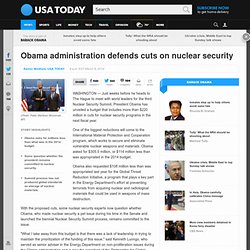
One of the biggest reductions will come to the International Material Protection and Cooperation program, which works to secure and eliminate vulnerable nuclear weapons and materials. Obama asked for $305.5 million, or $114 million less than was appropriated in the 2014 budget. Obama also requested $108 million less than was appropriated last year for the Global Threat Reduction Initiative, a program that plays a key part in the Energy Department's effort at preventing terrorists from acquiring nuclear and radiological materials that could be used in weapons of mass destruction. Moniz said the administration is looking for ways to revive the MOX project with substantial cost reductions. "But the real question is, 'Is it enough? '" Cns.miis.edu/opapers/pdfs/140107_trillion_dollar_nuclear_triad.pdf.
Analysts: $1 Trillion U.S. Nuclear-Weapons Plan Too Costly To Implement. PrintShareEmailTwitterFacebookLinkedIn By Douglas P.
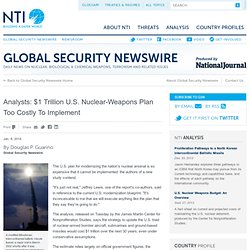
Guarino Global Security Newswire. Www.cbo.gov/sites/default/files/cbofiles/attachments/12-19-2013-NuclearForces.pdf. CBO: 10-Year Nuclear Plan Will Cost $355 Billion. Nuclear Studies and Republican Disarmers » FAS Strategic Security Blog. .
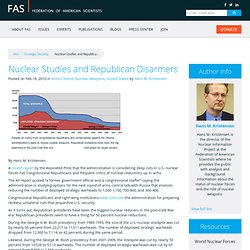
By Hans M. Kristensen A recent report by the Associated Press that the administration is considering deep cuts in U.S. nuclear forces has Congressional Republicans and frequent critics of nuclear reductions up in arms. The AP report quoted “a former government official and a congressional staffer” saying the administration is studying options for the next round of arms control talk with Russia that envision reducing the number of deployed strategic warheads to 1,000-1,100, 700-800, and 300-400.
Nuclear weapon reductions must be part of strategic analysis. We supported ratification of the START treaty.
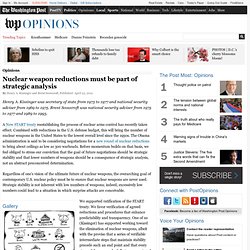
We favor verification of agreed reductions and procedures that enhance predictability and transparency. One of us (Kissinger) has supported working toward the elimination of nuclear weapons, albeit with the proviso that a series of verifiable intermediate steps that maintain stability precede such an end point and that every stage of the process be fully transparent and verifiable. The precondition of the next phase of U.S. nuclear weapons policy must be to enhance and enshrine the strategic stability that has preserved global peace and prevented the use of nuclear weapons for two generations. Eight key facts should govern such a policy: First, strategic stability requires maintaining strategic forces of sufficient size and composition that a first strike cannot reduce retaliation to a level acceptable to the aggressor. The Nuclear Weapons Budget. I believe that US nuclear forces, policies and posture are mis-aligned with today’s security environment.
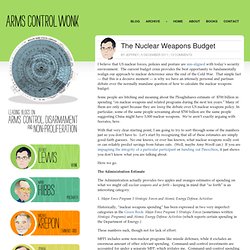
Vulnerable at 2,672 Nuclear Warheads? In a recent article, Jeffrey Lewis of Arms Control Wonk outlined what could happen to U.S. nuclear forces under a sequestration budget.
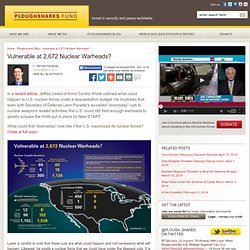
He illustrates that even with Secretary of Defense Leon Panetta’s so-called “doomsday” cuts to nuclear weapons related activities, the U.S. could still field enough warheads to greatly surpass the limits put in place by New START. What could that “doomsday” look like if the U.S. maximized its nuclear forces? (View at full size) Lewis is careful to note that these cuts are what could happen and not necessarily what will happen. Likewise, he posits a nuclear force that we could have under the deepest cuts. 12/06/11 UPDATE: A reader correctly noted that sequestration cuts in total dollars did not match Jeffery Lewis' article. 12/06/11 UPDATE: To avoid any confusion, we have removed the total dollar figure from the post. Sources: Jeffrey Lewis and Hans Kristensen Research: Mary Kraszynski Creative/Art Direction: Peter Fedewa. Nuclear Plan Shows Cuts and Massive Investments » FAS Strategic Security Blog.
By Hans M.
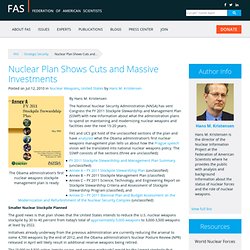
Kristensen The National Nuclear Security Administration (NNSA) has sent Congress the FY 2011 Stockpile Stewardship and Management Plan (SSMP) with new information about what the administration plans to spend on maintaining and modernizing nuclear weapons and facilities over the next 15-20 years. GAO Report Challenges Nuclear Weapons Spending Spree » FAS Strategic Security Blog. .
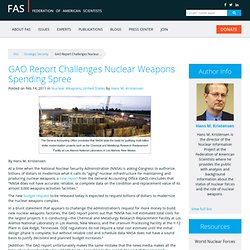
By Hans M. Kristensen At a time when the National Nuclear Security Administration (NNSA) is asking Congress to authorize billions of dollars to modernize what it calls its “aging” nuclear infrastructure for maintaining and producing nuclear weapons, a new report from the General Accounting Office (GAO) concludes that “NNSA does not have accurate, reliable, or complete data on the condition and replacement value of its almost 3,000 weapons activities facilities.” The Nuclear Weapons Modernization Budget » FAS Strategic Security Blog. The FY2012 budget request includes considerable nuclear weapon modernization By Hans M.

Kristensen.